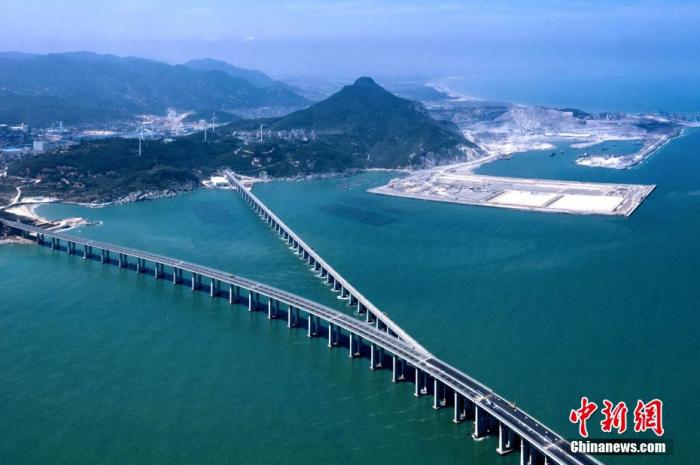China News Service, Beijing, December 26th. Question: What are the specialties about the "selecting dates" for the opening of multiple railways on the same day or the start of construction?
China News Agency reporter Wang Qingkai
The opening of the Yinxi High-speed Railway and the Fuping Railway...December 26 was a good day, and many railways in China were opened on the same day.
An insider in the transportation industry told a reporter from China News Agency that it is the practice of the past years to concentrate on opening to traffic in various places at the end of the year.
In addition, the New Year's Day and Spring Festival transportation will start soon, and the opening to traffic at the end of the year will play a role in the peak of railway transportation at the end of the year.
The picture shows a bird's-eye view of China's first road-rail dual-use bridge-the Pingtan Strait Road-Rail Bridge.
Photo by Wang Dongming
As for why it was chosen today?
He believes that December 26 is the last weekend of 2020, which is the main reason.
As of the end of 2019, China's railway operating mileage was 139,000 kilometers, of which high-speed railways exceeded 35,000 kilometers, ranking first in the world.
Yinxi high-speed rail opens to traffic: Ningxia is officially connected to the national high-speed rail network
At 9 am on the 26th, with the D4385 EMU leaving Yinchuan Station, the Yinchuan-Xi'an high-speed railway was officially opened for operation.
The opening of this high-speed rail line is of great significance: not only has the railway running time between Yinchuan and Xi'an reduced from 14 hours to 3 hours, but also marked the official access of Ningxia to the national high-speed rail network.
The Yinxi High-speed Railway connects Ningxia, Gansu, and Shaanxi provinces. It is an important part of China's "eight vertical and eight horizontal" high-speed railway network Baotou (Yinchuan) to Haikou channel. It is China's first crossing the edge of the Mu Us Desert and the largest loess plateau in the world. The high-speed railway in Taiyuan District is also the longest ballasted high-speed railway built at one time in China.
The opening of the Yinxi High-speed Railway to traffic is of great significance for promoting regional economic and social development, helping the revitalization of old revolutionary areas, and advancing the implementation of the strategy of developing the western region.
The opening of Fuping Railway: the world's longest road-rail dual-use cross-sea bridge is put into use
"Seven years of hard work, I think it's all worth it at this moment." Looking at the first high-speed rail that slowly passed the Pingtan Strait Highway Bridge, Zhang Hongxin, deputy general manager of China Railway Bridge Bureau, couldn't help feeling.
With the G5322 train leaving Pingtan Station, the Fuzhou Ping (Tan) Railway was officially opened for operation on the 26th, and China's first road-rail dual-use sea-crossing bridge, the Pingtan Strait Road-Rail Bridge, was also put into use simultaneously.
The Pingtan Strait Highway and Railway Bridge is a key control project of Fuping Railway, with a total length of 16.34 kilometers, of which the cross-sea section exceeds 11 kilometers.
The Pingtan Strait Highway and Railway Bridge is a miracle created in the "bridge construction restricted zone".
The location of the bridge has the characteristics of strong wind, high waves, deep water and rapid currents.
According to statistics, the bridge construction team has obtained 73 patents and is applying for 136 patents.
Opening of the "Two Lines and One Station" in Hunan: Breaking through the transportation bottlenecks in five provinces, regions and cities
Yuhuai Railway (Chongqing Yubei to Hunan Huaihua) additional line 2, Jiaoliu Railway (Henan Jiaozuo to Guangxi Liuzhou) Huai Liu electrification transformation, Huaihua West Marshalling Station ("two lines and one station") also officially opened on the 26th.
In this regard, the functions of the Huaihua railway hub will be more complete, and the railway capacity of the border areas of Hunan, Hubei, Chongqing, Guizhou, and Guangxi will be greatly increased.
After the "two lines and one station" are put into operation, the railway transportation capacity will be increased by more than four times, which will effectively solve the railway transportation bottleneck in the five provinces, regions, and border regions, and ease the tension in the external transportation capacity of the central and western regions of Hunan.
Ganshen high-speed rail track laying: construction enters sprint stage
In addition to the opening of a number of railways, many projects under construction also announced new developments on the 26th.
On the morning of the 26th, the Ganshen high-speed railway line began to lay the track, and the project construction entered the sprint stage.
The Ganshen high-speed railway is an important part of the Beijing-Hong Kong high-speed railway, the main channel of the national "eight vertical and eight horizontal" high-speed railways. The line starts from Ganzhou, Jiangxi in the north, to Shenzhen, Guangdong in the south. The main line is 436.37 kilometers long and has a design speed of 350 kilometers per hour.
After the completion of the Ganshen high-speed rail, Nanchang via Ganzhou to Shenzhen will arrive in about 3.5 hours at the fastest; Shanghai to Shenzhen will achieve the full high-speed rail journey, and the travel time will be shortened from the current fastest 11 hours to about 7 hours, which will accelerate the development of the Yangtze River Delta city cluster The integrated development of the Guangdong-Hong Kong-Macao Greater Bay Area is of great significance.
The Liuzhou-Wuzhou section of the Liuzhou-Guangzhou railway project was also announced on the 26th in Liuzhou City, Guangxi, which is a railway that has made local people look forward to a hundred years.
The railway originated from Sun Yat-sen's vision a hundred years ago. Today, the railway dream of the century will become a reality, promoting Guangxi's integration into the Guangdong-Hong Kong-Macao Greater Bay Area.
(Finish)

